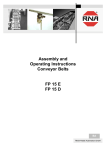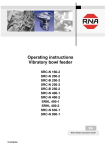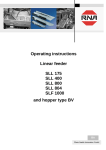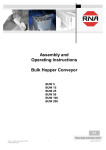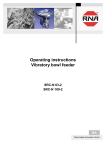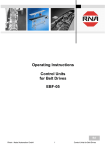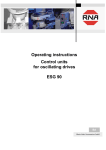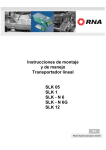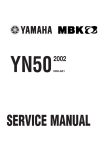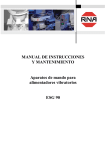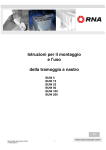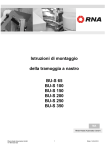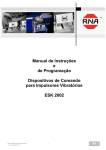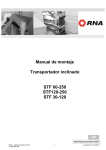Download Operating instructions Linear feeder GL 1 GL 01
Transcript
Operating instructions Linear feeder GL 1 GL 01 BA Rhein-Nadel Automation GmbH Contents 1 Technical data Page 2 2 Safety instructions Page 3 3 Construction and function of the linear feeder Page 4 4 Transport and mounting Page 4 5 Starting/Adjustment Page 5 6 Specifications for the design of the track Page 6 7 Maintenance Page 7 8 Stockkeeping of spare parts and after-sales service Page 7 9 What to do, if....? Instructions for trouble-shooting Page 7 Notice All linear feeders listed in the table may only be operated in connection with a RNA control unit at a mains voltage of 230V/50Hz. Special voltages and frequencies see separate data sheet. 1 Technical data Linear feeder type Dimensions L x W x H Weight Insulation type Connecting cable length Power consumption (1) Current consumption (1) Magnet nominal voltage (1)/Frequency Number of magnets Magnet type Magnet colour Air gap Vibration frequency Number of spring assemblies Standard no. of springs Number per spring assembly Spring dimensions Length (gauge for boreholes) x width Spring size Quality of the spring fastening screws Tightening moment of the spring fastening screws Max. weight of the oscillatingunits (linear track) depending on the mass moment of inertia and required running speed approx.kg Max. track length Maximum useful weight of the linear feeder GL 01 245 x 58 x 100 3,8 IP 54 1,4 120 0,6 200/50 1 WZAW040X00D05 black 1,0 100/6000 2 2x4 GL 1 400 x 105 x 100 8,7 IP 54 1,4 173 0,865 200/50 1 WZAW060X00D25 black 1,2 100/6000 2 2x5 in mm 45(35)x25(15) 87(67)x20 in mm in Nm 0,5 8,8 11 1,5 8,8 25 in kg approx. 1-2,5 approx. 2-4 in mm in kg 400 3 600 5 in mm in kg in m in VA in A in V/Hz in mm in Hz/min (1) At special connecting values (voltage/frequency) see type plate at the magnet Rhein - Nadel Automation GmbH GB-C-2 Linear feeder GL 1 / 01 sure that the connected load of the linear feeder, control unit and power supply is compatible. Pin assignment Notice The linear feeder may only be operated in perfect condition! The linear feeder may not be operated in the explosive or wet area. The linear feeder may only be operated in the configuration drive unit, control unit and oscillating unit, as specified by the manufacturer. 2 Safety instructions The conception and production of our linear feeders has been carried out very carefully, in order to guarantee trouble-free and save operation. You too can make an important contribution to job safety. Therefore, please read this short operating instruction completely, before starting the machine. Always observe the safety instructions! Make sure that all persons working with or at this machine carefully read and observe the following safety instructions! This operating instruction is only valid for the types indicated on the front page. Notice his hand points to information that gives you useful tips for the operation of the linear feeder. No additional loads may act upon the linear feeder, apart from the material to be transported, for which the special type is designed. Attention It is strictly prohibited to put any safety devices out of operation! Demands on the user • For all activities (operation, maintenance, repair, etc.) the details of the operating instructions must be observed. • The operator has to avoid any working method which would impair the safety of the linear feeder. • The operator must take care that only authorized personnel works at the linear feeder. • The operator is obliged to inform the operator immediately about any changed conditions at the linear feeder that could endanger safety. Attention The linear feeder may only be installed, put into operation and serviced by expert personnel. The binding regulation for the qualification of electricians and personnel instructed in electrical engineering is valid, as defined in IEC 364 and DIN VDE 0105 part 1. Attention This warning triangle marks the safety instructions. Non-observance of these warnings can result in serious or fatal injuries! Dangers occuring at the machine • Make sure that the protector ground of the electric power supply is in perfect condition! Attention: Since the electromaget-field may have an impact on persons arrying pacemakers it is recommended to keep a minimum distance of 25 cm. • Operation of the linear feeder without trim panel is strictly prohibited! Proper use The intended use of the linear feeder is the actuation of conveying tracks. These are used for linear transport and feeding of correctly positioned massproduced parts, as well as for the proportioned feeding of bulk material. Noise emission The intended use also includes the observance of the operating and servicing instructions. The noise level at the place of operation depends on the complete equipment and the material to be sorted. The determination of the noise level according to the EC-Regulations "Machinery" can therefore only be carried out at the place of operation. Please take the technical data of your linear feeder from the table "technical data" (see chapter 1). Make If the noise level at the place of operation exceeds the limit permitted, noise protection hoods may be Rhein - Nadel Automation GmbH GB-C-3 Linear feeder GL 1 / 01 used, which we offer as accessory parts (see catalogue). conduction. The vibration frequency therefore is 100 Hz. Standards and regulations A linear feeder is a resonant system (spring-masssystem). The result is that the adjustment made at the plant will rarely meet your requirements. Chapter 5 describes how your linear feeder is adapted to your requirements. The device was built according to the following standards and regulations: • • • • • • • • 3 EC- Directive Machinery 98/37/EC EC- Low voltage directive 73/23/EC EMC- Directive 89/336/EC Applied harmonized Standards EN 60204, T.1 EN 292, T.1 and T.2 Applied national technical standards VGB 4 VGB 10 Rheinnadel- Conditions for purchasing VDE- Standards VDMA- Conditions of delivery Controlling of the linear feeder takes place by a low loss electronic control unit type ESG 90. The control unit of the linear feeder is separately delivered. At its front panel it is provided with a 7-pole plug-in connection, by which it is connected to the linear feeder. The pin assignment of the socket is shown in the table "technical data" (chapter 1). Notice Detailed information on the complete range of control units may please be taken from the operating instructions for control units Construction and function of the linear feeder All control units have got two main operating elements: Linear feeders are used for the actuation of sorting machines. The actuation takes place by electromagnets. The following schematic diagram shows the function of a linear feeder: • By the main switch the linear feeder is switched on or off. • By the turning knob the conveying caacity of the sorting unit is set. 4 Transport and mounting Transport Notice Take care that the linear feeder cannot dash against other things during transport A B C D E F G The weight of the linear feeder is taken from the table „technical data“ (chapter 1.) Conveying track and oscillating weight Material to be conveyed Spring assembly Drive magnet Armature Counter-mass Vibration buffers The linear feeder is a device of the familiy of vibratory bowl feeders. It is, however, equipped with a linear conveyor. Electromagnetic vibrations are converted into mechanical vibrations and are used for conveying material B. When the magnet D, which is fixedly connected with the counter-mass F, is supplied with current, it generates a power that, dependent on the vibration frequency of the mains supply, attracts and releases armature E. Within a period of the 50 Hz of the A.C. network the magnet achieves its maximum power of attraction twice, as this is independent of the direction of the current Rhein - Nadel Automation GmbH Mounting The linear feeder should be mounted on a stable substructure (available as accessory part) at the place where it is used. The substructure must be dimensioned in a way that no vibrations of the linear feeder can be carried away. Linear feeder are fastened to the vibration buffers from below (part G in the general drawing chap. 3). The following table give you a summary of the bore date of the various types: Linear feeder type GL 01 GL 1 Length in mm Width in mm 152 285 40 70 Vibration buffer thread M4 M6 Table bore data GB-C-4 Linear feeder GL 1 / 01 Make sure that the linear feeder cannot come into contact with other devices during operation. Further details on the control unit (bore plan, etc.) are please taken from the operating instructions of the control unit separately delivered. 5. Starting Preparations Notice Ensure that the frame ( stand, base, frame etc.) is connected with the ground wire. (PE) If necessary, predection earthing on spot should be provided. Check, whether • the linear feeder stands in an isolated position and does not come in contact with a solid body • the linear track is fixedly screwed down and adjusted • the connecting cable of the linear feeder is plugged in at the control unit. Attention The electric connection of the linear feeder may only be made by trained personnel (electricians)! In case modifications are made at the electric connection, it is absolutely necessary to observe the operating instructions "control units". • The available supply voltage (frequency, voltage, output) is in accordance with the connection data of the control unit (see type plate at the control unit). Plug in the mains cable of the control unit and switch on the control unit by the mains switch. Notice At linear feeders which are delivered as a completely adjusted system, the optimal conveying capacity is already set in the factory. It is marked on the scale of the turning knob with a red arrow. In this case set the turning knob to the marking The optimal operative range of the linear feeder is at a controller position of 80% at the control unit. In case of higher deviations (≥±15%) a new adjustment must be made. Adjustment of the running behaviour Notice At first a rough adjustment of the conveying speed (adjustment of the natural frequency must be made. After Rhein - Nadel Automation GmbH that the adjustment of the running behaviour. Finally you adjust the conveying speed (natural frequency). In order to convey the material with its highest (maximum) conveying speed, it must optimally rest on (in) the track, which means that the vertical amplitude should be zero, if possible. At long tracks the vertical amplitude can be too high, owing to the deflection of the track. The material to be conveyed then makes little jumps on the track and cannot be transported at all or only with low speed. In exceptional cases it may become necessary to compensate the fluttering of the track at the ends by modifying the counter-weight. In case the workpieces make little jumps at the discharge side or in case the material to be conveyed runs backward, the counterweight must be increased (stepwise by approx. 50 g). In case the workpieces make little jumps at the feeding side (magnet side) or if their is no conveying movement at the discharge side, the counter-weight must be decreased. Adjustment of the natural frequency In case the linear feeders are delivered without track, they has been adjusted in the plant to average weights of the oscillating elements. In order to guarantee an optimal conveying behaviour, the linear feeder must be adjusted to the definite operating conditions. The adjustment is made by adding or removing leaf springs and washers. First check, whether the right control unit (frequency, voltage, power supply, (see table "technical data" in chapter 1) has been connected. Carry out the following steps: • Screw off the side panels. Tighten all spring fastening screws and track fastening screws. Please take the tightening moments of the spring fastening screws from the table technical data (chapter 1). • Check, whether the magnet corresponds to the specifications in the "technical data" (voltage, frequency). • Measure the magnet-air gap. In case it differs from the specifications in the "technical data", adjust it correctly. • Fill the tracks with material to be conveyed and turn the turning knob of the control unit to 90 % of the conveying capacity. • Loosen a fastening screw at one of the spring assemblies • (approx. 1/4-1/2 rotation). While the spring fastening screw is loosened, you can see a change in the conveying speed. The following graphic chart shows the resonance curve of a linear feeder: GB-C-5 Linear feeder GL 1 / 01 magnetic gap the magnet may not dash against the armature when switching on the device. The aim of the adjustment is: If the required conveying speed is achieved at a controller position of 80 %, the conveying speed must always decrease when the spring fastening screw is loosened. A B C D Notice Take care that the number of springs per spring assembly does not differ by more than 2-3 springs. Conveying speed Resonant frequency of the system Resonance curve (not true to scale) Spring power Notice The resonant frequency of the linear feeder may not correspond to the mains frequency In case the conveying capacity decreases after loosening the spring fastening screw, proceed as described under point 5.1. In case, however, the conveying capacity, increases, proceed as described under point 5.2. Notice The adjustment is, however, more easy with an electronic frequency converter, which you can buy from our range of accessory parts. The linear feeder should be adjusted that the required conveying capacity is achieved at a controller position of approx. 80% at the control unit. 5.1 The conveying speed decreases? Mount additional springs (with distance plates). Start with one additional spring (with washer) at one spring assembly. In case the conveying speed still decreases, although an additional fastening screw is loosened, install one additional spring in each individual spring assembly (one after the other). 5.2 The conveying speed increases? Remove the springs. First remove one spring (with washer) from a spring assembly. In case the conveying speed still increases, although an additional fastening screw is loosened, remove one spring from each individual spring assembly (one after the other). After removing and mounting of the leaf springs the linear feeder must be readjusted. Adjustment of the linear feeder type GL 01: Tighten the spring fastening screws with the specified tightening torque (see "technical data" chapter 1). Control and keep to the mounting dimension (oscillator height) of 85 mm at all four edges of the linear feeder. Before starting the side plates must be mounted. Adjustment of the linear feeder type GL 1: For the adjustment of the oscillator in parallel to the counter-mass four leaf springs are included in the delivery. These leaf springs must be inserted between the spring assemblies and the distance cams (one each above and below). After that the spring fastening screws must be tightened with the specified tightening torque (see "technical data" chapter 1). Before starting the distance springs must be removed and the side plates must be mounted. 6 Specifications for the design of the track The projection of the track in longitudinal direction towards the oscillator should be at a ratio of 1/3 feeding side to 2/3 discharge side. The tracks must be of solid construction. upright beams with a high moment of resistance are to be preferred (U-beams, rectangular tubes, etc.). Notice The side plates must always be mounted for test runs Especially tracks for thin material as eg. stamped metal parts, etc. should be manufactured with the greatest possible clearance between material to be conveyed and cover. Here it must, however, be guaranteed that the material to be conveyed does not run one piece on top of the other or becomes wedged together. Notice At a turning knob position of 100 % at the control unit and correctly adjusted The track should be located in the middle of the oscillator. By no means it may be installed in a way that one side projects over the oscillator. Rhein - Nadel Automation GmbH GB-C-6 Linear feeder GL 1 / 01 8. 7 Maintenance The linear feeders are generally maintenance-free. They should, however, be thoroughly cleaned when they are considerably dirty or after fluids have been spilled over them. • For that first unplug the mains plug. • Remove the side plates. • Clean the inside of the linear feeder, especially the magnetic gap. • After mounting the side plates and plugging in the mains plug, the linear feeder is ready for operation again. 9 Stockkeeping of spare parts and after-sales service. The range of the spare parts available may be taken from the separate spare parts list. In order to guarantee quick and faultless handling of the order, please always state the type of equipment (see type plate), number of pieces needed, spare part name and spare part number. You will find a list of our service addresses on the back page of the cover What is to do, if... Instructions for trouble-shooting Attention The control unit or the connecting terminal box may only be opened by an electrician. Before opening the a.m. devices, the mains plug must be unplugged! Trouble Linear feeder does not start when being switchen on Possible cause Mains switch off Remedy Switch on the mains switch Mains plug of the control unit is not plugged in Plug in the mains plug. Connecting cable between linear feeder and control unit is not plugged in Plug in the 7-pole plug at the control unit Replace the fuse Linear feeder vibrates slightly Fuse in the control unit defective Turning knob at the control unit is set to 0% Wrong vibration frequency Attention: in case a linear feeder for 6000 vibrations/minute is operated with a 7-pole plug without bridge, the control unit and the magnet is in danger! After a longer operating Fastening screws of the linear track have worked time the linear feeder does loose no longer come up to the conveying capacity Screws at one or two spring assemblies have required worked loose Set the controller to 80%. Check, whether the code in the plug of the linear feeder is correct (see type plate and "technical data" (chap. 1) Retighten the screws. Tighten the screws (tightening torques see "technical data" (chapt. 1) Replace the broken springs Magnetic gap misadjusted Readjust the oscillator (see chapt. 5) Springs are broken Linear feeder produces loud noise Oscillator has displaced itself towards the countermass Fastening screws of the side plates have worked loose Foreign bodies in the magnetic gap Linear feeder cannot be adjusted to a constant conveying speed The spring constant of the oscillating system has changed. The linear feeder works close to the resonance point Rhein - Nadel Automation GmbH GB-C-7 Retighten the screws Switch off the linear feeder and remove the foreign bodies, after that check the magnetic gap adjustment Readjust the linear feeder. Springs must be removed. See chapt. 5, adjustments Linear feeder GL 1 / 01 Rhein-Nadel Automation GmbH Reichsweg 19/42 y D - 52068 Aachen Tel (+49) 0241/5109-159 y Fax +(49) 0241/5109-219 Internet www.rna.de y Email [email protected] Rhein-Nadel Automation GmbH Zweigbetrieb Lüdenscheid Nottebohmstraße 57 y D - 58511 Lüdenscheid Tel (+49) 02351/41744 y Fax (+49) 02351/45582 Email [email protected] Rhein-Nadel Automation GmbH Zweigbetrieb Ergolding Ahornstraße 122 y D - 84030 Ergolding Tel (+49) 0871/72812 y Fax (+49) 0871/77131 Email [email protected] HSH Handling Systems AG Wangenstr. 96 y CH - 3360 Herzogenbuchsee Tel +(41) 062/95610-00 y Fax (+41) 062/95610-10 Internet www.rna.de y Email [email protected] RNA AUTOMATION LTD Hayward Industrial Park Tameside Drive, Castle Bromwich GB - Birmingham, B 35 7 AG Tel (+44) 0121/749-2566 y Fax (+44) 0121/749-6217 Internet www.rna-uk.com y Email [email protected] Vibrant S.A. Pol. Ind. Famades C/Energia Parc 27 E - 08940 Cornella Llobregat (Barcelona) Tel (+34) 093/377-7300 y Fax (+34) 093/377-6752 Internet www.vibrant-rna.com y Email [email protected] RNA Automated Systems Inc. 1349 Sandhill Drive Unit 101 Ancaster, Ontario Canada, L9G 4V5 Tel (+1) 905/3049950 y Fax (+1) 905/3049951 Mobil (+1) 905/9756562 Email [email protected] www.rna-can.com VT-BA-GL-GB-00 Stand: 05.06.06 8 Linear feeder GL 1 / 01








